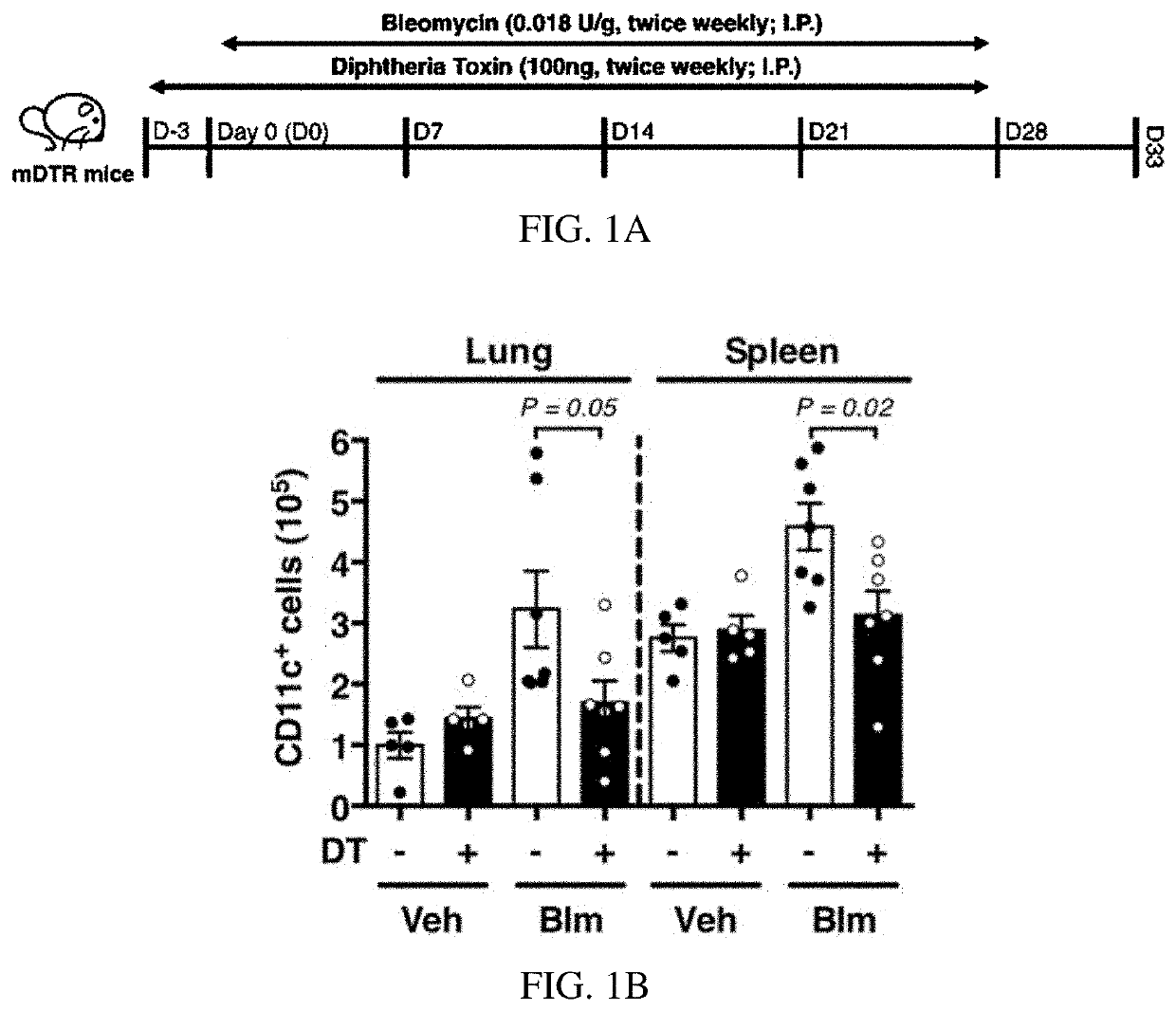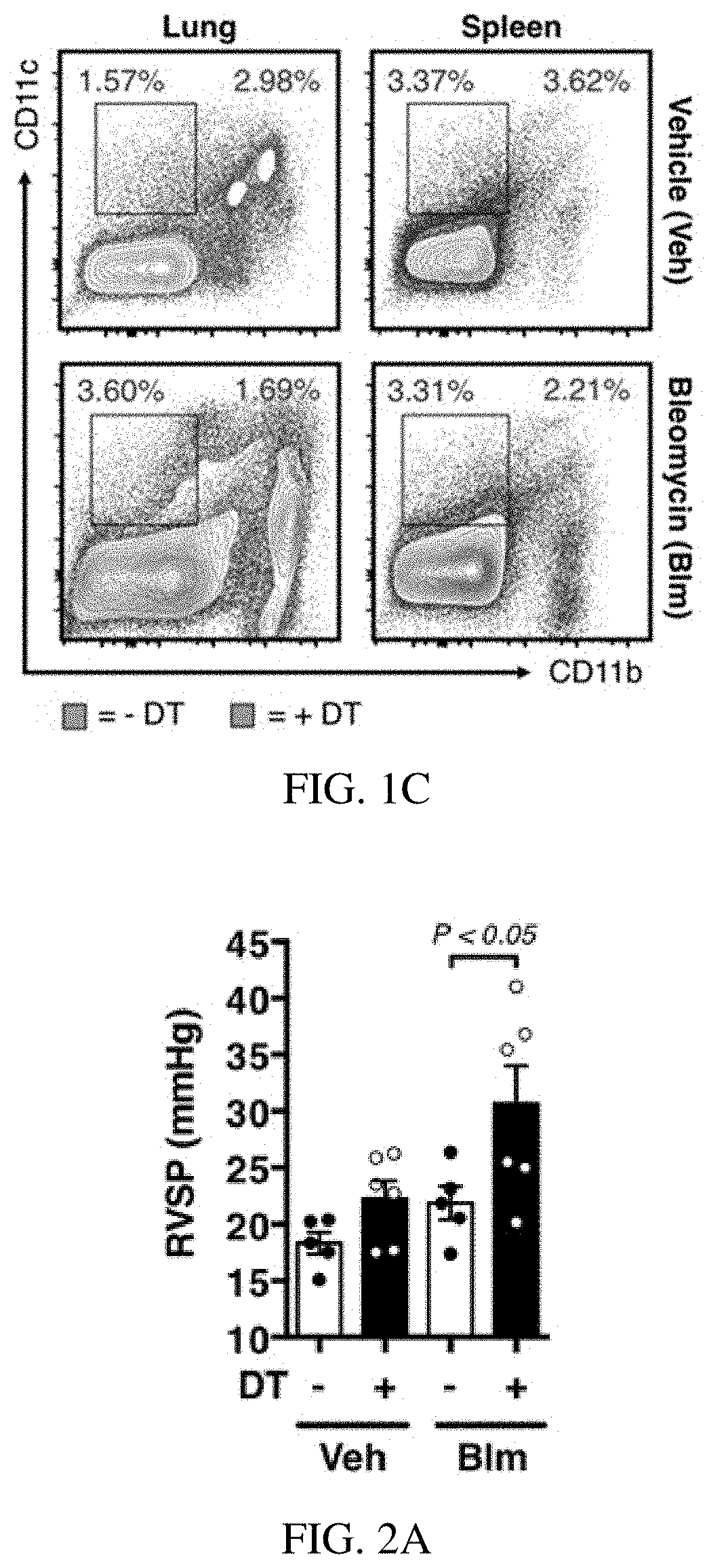Pdl-1 inhibitors in treatment of pulmonary vascular diseases
a pulmonary artery disease and pdl-1 technology, applied in the field of pdl1 inhibitors in the treatment of pulmonary artery diseases, can solve the problems of difficult heart pumping, lack of well-understood mechanism for the development of the disease in many patients, and increase the activation of cd8+ t cells, so as to reduce the mdsc arginase 1 (arg1), reduce the immunosuppressive capacity, and improve the effect o
- Summary
- Abstract
- Description
- Claims
- Application Information
AI Technical Summary
Benefits of technology
Problems solved by technology
Method used
Image
Examples
example 1
[0141]Emergency Myelopoiesis Contributes to Pulmonary Vascular Remodeling, and Pulmonary Hypertension, with No Alteration in Pulmonary Fibrosis
[0142]Emergency myelopoiesis is primarily an evolutionary conserved response to infectious disease, whereby immature bone marrow-derived cells replenish those mature leukocytes lost in combatting illness (Chiba et al., 2018). It has recently been demonstrated that emergency myelopoiesis can be induced in response to intraperitoneal macrophage apoptosis induced by clodronate liposome injections (Bryant et al., 2018), building upon prior work demonstrating an increase in granulopoiesis, specifically, in response to chronic clodronate liposome administration in a model of cardiac injury (van Amerongen, Harmsen, van Rooijen, Petersen & van Luyn, 2007). Intriguingly, cell-specific targeting of myeloid cells themselves—using a LysM.Cre-DTR, or “mDTR”, mouse model—has likewise been shown to elicit increased granulopoiesis with an expansion in circul...
example 2
Immune Cell Expression of PD-1 / PD-L1 is Enhanced in Pulmonary Hypertension Secondary to Pulmonary Fibrosis
[0148]With this understanding, it was sought to determine the contributory effects of myeloid cell PD-L1 expression on pulmonary vasculature in response to pulmonary fibrosis. To address this query, widespread, yet controlled, selective cellular apoptosis was induced in a model of pulmonary fibrosis with PH, reporting expression of PD-L1 / PD-1 as a viable target to promote normal repair of the injured pulmonary circulation.
[0149]MDSC presence is known to be associated with T cell exhaustion and senescence via programmed cell death protein 1 (PD-1) upregulation on effector T cells, establishing the rationale for PD-1 / programmed death-ligand 1 (PD-L1) signaling blockade as an effective immune therapy for many cancers (Huang, Francois, McGray, Miliotto & Odunsi, 2017). Thus, the level of PD-1 expression on T cell sub-populations was determined in this model of PH. Significant differ...
example 3
[0153]Patients with Interstitial Lung Disease Complicated by Pulmonary Hypertension Display an Increase in PD-L1 Expression by Circulating Myeloid Cells
[0154]Given the preclinical relevance these studies suggest in conceivable treatment of patients with Group 3 PH, it was next sought to investigate differences in myeloid cell expression of PD-L1 (CD274) in peripheral blood samples from healthy controls (HC), and patients with interstitial lung disease with (ILD+PH) and without (ILD) PH. Using a previously described classification schema (Bronte et al., 2016), CD274 expression was quantified on CD33+CD11b+CD14−CD15+ cells (PMN-MDSC, human) and found that cells from patients with ILD+PH displayed higher levels of the checkpoint protein, compared to both controls and patients with simply ILD (FIG. 9A). These data are consistent with published work documenting an increase in CD274 expression by MDSC in a separate cohort of patients with pulmonary arterial hypertension (PAH) (Bryant et a...
PUM
| Property | Measurement | Unit |
|---|---|---|
| dissociation constant | aaaaa | aaaaa |
| dissociation constant | aaaaa | aaaaa |
| dissociation constant | aaaaa | aaaaa |
Abstract
Description
Claims
Application Information
 Login to View More
Login to View More - R&D
- Intellectual Property
- Life Sciences
- Materials
- Tech Scout
- Unparalleled Data Quality
- Higher Quality Content
- 60% Fewer Hallucinations
Browse by: Latest US Patents, China's latest patents, Technical Efficacy Thesaurus, Application Domain, Technology Topic, Popular Technical Reports.
© 2025 PatSnap. All rights reserved.Legal|Privacy policy|Modern Slavery Act Transparency Statement|Sitemap|About US| Contact US: help@patsnap.com



